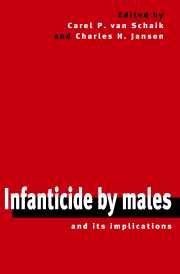
-
Select format
-
- Publisher:
- Cambridge University Press
- Publication date:
- November 2009
- November 2000
- ISBN:
- 9780511542312
- 9780521772952
- 9780521774987
- Dimensions:
- (228 x 152 mm)
- Weight & Pages:
- 1.062kg, 584 Pages
- Dimensions:
- (228 x 152 mm)
- Weight & Pages:
- 0.935kg, 584 Pages
- Subjects:
- Animal Behaviour, Life Sciences, Zoology
You may already have access via personal or institutional login- Subjects:
- Animal Behaviour, Life Sciences, Zoology
Book description
Male primates, carnivores and rodents sometimes kill infants that they did not sire. Infanticide by males is a relatively common phenomenon in these groups, but tends to be rare in any given species. Is this behavior pathological or accidental, or does it reflect a conditional reproductive strategy for males in certain circumstances? In this book, case studies and reviews confirm the adaptive nature of infanticide in males in primates, and help to predict which species should be vulnerable to it. Much of the book is devoted to exploring the evolutionary consequences of the threat of infanticide by males for social and reproductive behavior and physiology. Written for graduate students and researchers in animal behavior, behavioral ecology, biological anthropology and social psychology, this book shows that social systems are shaped not only by ecological pressures, but also social pressures such as infanticide risk.
Reviews
‘… useful to anyone whose research concerns involve infanticide especially infanticide by primate males.’
Source: Ethology
Contents
Metrics
Altmetric attention score
Full text views
Full text views help Loading metrics...
Loading metrics...
* Views captured on Cambridge Core between #date#. This data will be updated every 24 hours.
Usage data cannot currently be displayed.
Accessibility standard: Unknown
Why this information is here
This section outlines the accessibility features of this content - including support for screen readers, full keyboard navigation and high-contrast display options. This may not be relevant for you.
Accessibility Information
Accessibility compliance for the PDF of this book is currently unknown and may be updated in the future.


